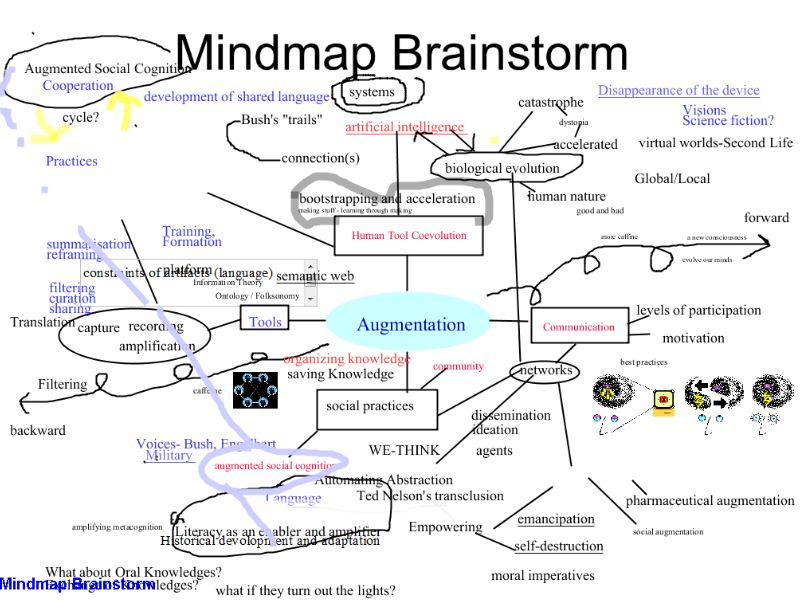I just finished the first session of Howard Rheingold’s online Think-Know course. It seems the participants are an amazing group of people dispersed over several continents. The next weeks we’ll dive into both the theoretical-historical background of intellect augmentation and the practical skills of personal knowledge management.
We’ve been reading Rheingold’s Tools for Thought (available online), As we may think (Vannevar Bush), Augmenting Human Intellect: a conceptual framework (Douglas Engelbart) and Man-Computer Symbiosis (JCR Licklider). Dates of publication: first edition of Tools for Thought was in 1985, As We May Think was published in 1945, Man-Computer Symbiosis in 1960 and Augmenting Human Intellect in 1962.
Why bother reading those old texts about a fast-moving technology? My personal opinion: because we don’t move that very fast. We tend to use new technology to repeat old formats. We had print books, we’ll make ebooks now which try to be as print book-like as possible. We have print newspapers, well, even this day and age newspapers online try to imitate their print look and feel. It’s like the fledgling movie industry once was, trying to capture theater pieces rather than making actual movies.
The visionaries, living during the Second World War or during the Cold War, were convinced the world becomes very dangerous and moves very fast and in very complex ways. How can we humans cope with that, avoiding some horrible self-destruction? How can we make sense of the floods of information, data and noise? Those daring intellectuals dreamed up very new ways to read, write and collaborate – in fact, new ways to think. They were often too far ahead to be of much interest to commercial corporations, but the military were more than interested as they realized what was at stake.
How do we design interfaces which allow for new, in-depth, inspiring thought and collaboration? I think that data journalism, liveblogging, fluid and stream-like coverage, 3D visualization, local and contextual meaning, crap detection, filters and curation point the way to radical change, as do the artful organization of personal learning networks and tools such as combined databases/mindmaps. All this being made possible by ever-increasing computational power (raw power, but also ever more sophisticated software) and by the ever-shrinking devices we carry around (and which make our mind-amplifying electronic tools ubiquitous and hardly visible).
This course also makes us actually experiment with all this – for instance inciting us to collectively mindmap in real-time even though we are geographically totally dispersed. Here you see our raw mindmap (we’ll straighten it out during the coming days):
If you want more ‘old’ but extremely inspiring texts about mind-amplifying tools: the New Media Reader (MIT) is a must-read



Yes, the premise of The Singularity … that technology will advance at an ever-quickening pace until only machines will be able to keep up with it and adapt, leaving the “puny” human ability to stay abreast in the dust. But Howard is doing his damndest to educate people on how to cope as well as inspire them to develop new habits to take full advantage of the increasing flow (and that discerning crap from gold is a skill, not an intuitive quality). Big fan here. 🙂
I’m not sure Howard is a big believer in the Singularity. He seems to consider computers, networks etc as an augmentation of our capabilities, not as competition – at least for the coming years. At the end of the course – about six weeks from now – we’ll discuss the future more in-depth.
No, he isn’t (and I wasn’t implying that, sorry). Only that things are moving quickly and that Singularity idea illustrates the logarithmic speed at which the information glut is advancing. Maybe I should have referenced Toffler instead. 😉 In any case, people need tools and methods to keep up, sort it all out, and make the most productive use of it — that seems to be Mr. Rheingold’s mission.
the design of interfaces is ruled by the memes of the market now. 20 years ago, those asking better questions got paid little money. Today those paid the most, and whose interfaces travel the furthest, ask only the questions theyre paid to probe. “design for delight?” at facebook… oh really?